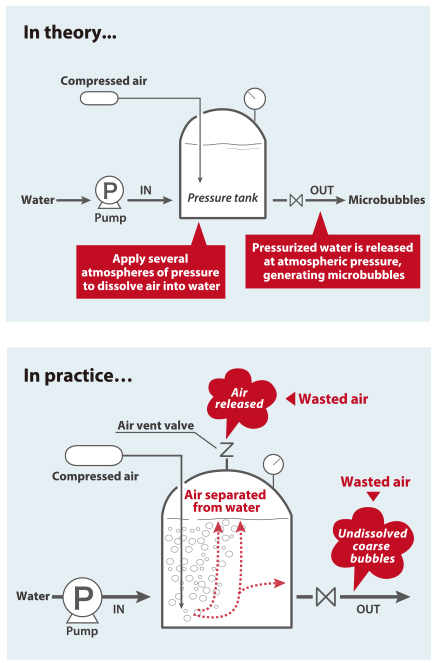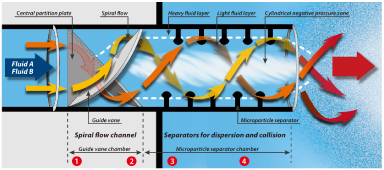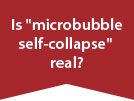Most DAF equipment produces inadequate microbubbles in inadequate quantities
The most important, but also most difficult, component of DAF (dissolved air flotation) systems is the generation of microbubbles, the vast majority of which is done with a pressure tank. However, pressure tanks make it very difficult both to adjust and to maintain the optimal pressure, so it is common in many places to leave the pressure tank in its initial configuration for long periods of time, generating virtually no microbubbles.
Worse still is that, microbubbles generated this way are both too large and too few, which impairs their ability to separate out suspended solids (SS). Large quantities of flocculant are therefore required for effective flotation.
Many water treatment companies have DAF systems but most use very crude methods. In fact, the majority of DAF systems in the majority of locations are inefficient.
Why pressure tanks produce inadequate microbubbles
Air does not readily dissolve in water

Henry’s law states the amount of dissolved air in water is proportional to its pressure upon the water. For example, a fivefold increase in pressure results in a fivefold increase in dissolved air. Pressure tank methods all rely on this law to produce microbubbles. The idea is to dissolve air into water at a pressure of several atmospheres before it leaves the pressure tank back at atmospheric pressure. This lowers the saturation limit to the point that dissolved air cannot remain dissolved, at which point it turns into fine bubbles (microbubbles).
In reality, however, it is wholly infeasible to maintain the conditions required to dissolve air in a full-scale pressure tank to the degree suggested by Henry’s law. This is because the instant that compressed air is blown into the pressurized tank, the vast majority of it will turn into coarse bubbles, which rapidly leave via the air vent valve or the pressure tank outlet before the air has a chance to dissolve. Please see the illustration on the right.
The pressure tank method has two fundamental flaws.
First, very little of the air blown in is actually converted into microbubbles; much of it ends up being wasted in the form of coarse bubbles. Injecting more air only serves to increase the number of coarse bubbles and has no effect on the number of microbubbles.
Second, it is extremely difficult to find and maintain optimal operating conditions because of natural fluctuations in pressure. These fluctuations, however small, affect the ratio of dissolved to undissolved air. Hence microbubbles cannot be generated consistently.
OHR’s microbubble generation is unlike any other
No pressure tank or daily adjustment required
 The great advantage of the OHR method is that it requires neither a pressure tank nor daily adjustment. Once the simple initial set-up is complete, it will deliver consistent, long-term performance. One OHR MIXER and one pump can together generate up to 15,000 L/min (900 m³/h) of microbubbled water.
The great advantage of the OHR method is that it requires neither a pressure tank nor daily adjustment. Once the simple initial set-up is complete, it will deliver consistent, long-term performance. One OHR MIXER and one pump can together generate up to 15,000 L/min (900 m³/h) of microbubbled water.
A more detailed explanation is available via the link below. Alternatively, please contact us directly.
OHR MIXER mechanism
Contact us
OHR microbubbles are finer and more effective for DAF
As demonstrated by an independent comparative test
 Company X, the biggest water treatment engineering company in Japan, collected and analysed data from three companies: company K, company N, and OHR. Microbubbled water generated by the equipment of these three companies was collected in 1 L measuring cylinders to observe how long it took for all of the microbubbles to disappear.
Company X, the biggest water treatment engineering company in Japan, collected and analysed data from three companies: company K, company N, and OHR. Microbubbled water generated by the equipment of these three companies was collected in 1 L measuring cylinders to observe how long it took for all of the microbubbles to disappear.
In the table of results to the right, you can clearly see that microbubbles produced according to the OHR method are much longer-lasting than other companies’.
In DAF systems, finer microbubbles are more desirable as fineness increases both the effectiveness and likelihood of bubbles raising the finer suspended solids (SS) to the surface. Different microbubble generators vary greatly in their ability to separate SS.












